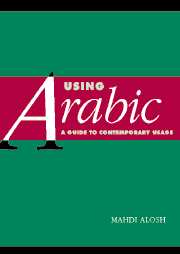Initial Review of Using Arabic by Mahdi Alosh
I purchased "Using Arabic: A Guide to Contemporary Usage" by Mahdi Alosh a week or so ago (See my previous post for more information aobut the book). I have spent a few hours going through the book since and have found it to be worth the 25$ I paid. The book is basically made up of two main sections - vocabulary and grammar. What I perhaps most enjoy about this book is the breadth of coverage. Most any grammatical aspect, usual or exceptional, is found in the book. The advantage of this book is that is written by an American Arab and it hasn't been translated from German or any other language. Yes, I am referring to certain reference grammars written in the 1800s and republished in the 1900s and 2000s. Those older grammar reference books seem to mostly attract stuffy old-school professors and diplomats who don't want to admit that spoken Arabic should be taught to students and that the glory of Arabic is found in knowing the most obscure structures that can only be used in the most uncommon of cirsumstances. This is, of course, only my anecdotal opnion.
My intial opinion of this book is that it is quite useful as a reference grammar for students of Arabic ranging from intermediate to advanced. The vocabulary sections could be better with some contextual sentences or readings, but it is useful in itself because it contains current phrases and words found in media, political and other genres.
This is the kind of book I might study from systematically day to day if I were in an intensive program. I would go through 5-10 pages a day and harvest the most useful vocabulary for memorization. I would then try to use the vocab throughout the day/week. As for the grammar, I would not spend too much time trying to internalize the rare aspects...but it would be useful to look through systematically as well.
Jeremy Palmer



